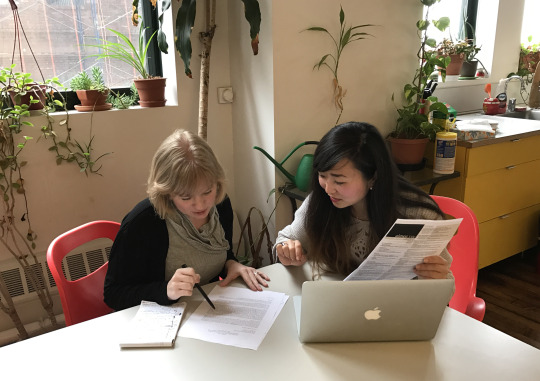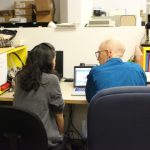Coach’s Corner: Cover Letters
Introducing a new blog series inspired by our NYFA Coaching pilot program. This first post is just in time for graduation season!
We were excited to recently debut a new professional development service for artists far and wide: NYFA Coaching. The pilot program offers personalized, one-on-one support for artists and administrators facing their own professional hurdles and deadlines. As an added facet of the program, we’re pleased to introduce “Coach’s Corner,” a blog series that tackles some of the topics that come up during coaching sessions with NYFA staff. In this post, and in anticipation of graduation season, Sarah Corpron, Acting Director of Business Services, offers a nuanced look at drafting a compelling cover letter for job applications. Here’s Sarah with more:
I’ve been thinking a lot about cover letters recently, and have been talking to artists and arts administrators who are looking for new jobs or considering career changes. As someone who has hiring experience, as well as having been an applicant myself, I want to share some of my own musings on the all important cover letter.
When should you write a cover letter?
If a job description explicitly tells you NOT to write a cover letter, then don’t. Otherwise, you should always write a cover letter!
An employer needs something that clues them into who you are and why you would be a valuable addition to their organization. Resumes are great, but they don’t tell the employer anything beyond the basics. When I read a cover letter, it gives me insight into that person’s passions, personality, and strengths. A good cover letter makes me pause and think about how that person might add to our team or bring a new point-of-view and experience set to our program. It also shows me that the applicant knows what we do and what the job will truly entail, beyond what was described in the listing.
Targeted research makes a difference!
Research the potential employer. “But Sarah, I already did that,” you say. Then do more! Our instinct as applicants is to research the employer so we know what it would be like to work there. We research with ourselves in mind: “Do I want this job? Do I like the work they do? How well do they pay or treat employees? Do they have a good reputation? Do I meet the base qualifications?” While this is great, it misses a key element: insight into what your reader, the employer, is looking for.
Take a step back and rethink your research approach with the employer’s need in mind. For example, ask yourself these questions: “What might be missing from the current team and how can I fill that gap? How can I support the organization’s programming and mission? What have I done in the past that directly connects to their work and mission? How will my experience and skill set elevate their own values and vision?” Think about these things as you research, so you can embed these insights into your cover letter.
Once your research is completed, the goal is to write a letter that reads like it was specifically made for that employer and that accurately represents you. I find it helpful to write too much and then edit things down to fit the specific audience I am writing for. Every industry is a little different, so keep the culture of the organization in mind when you consider formatting and content decisions. If they are a fairly formal institution, then a more formal letter and format makes sense! If this is the next design/tech start-up, then something that appeals to the risk-taking creative spirit in you might be better. Just be mindful of who will be looking at this and what image they project out to the world.
Start strong
The opening sentence to any letter is the hardest part to craft. It is easy to say “My name is X, and I am submitting information in response to the program officer position listed on your website.” Instead, start your cover letter with something engaging, something unique, and something that will grab the reader’s attention. You could try an opener that dives right into your own professional experience: “I am a dedicated arts administrator with over 10 years of experience in the for-profit and nonprofit arts sectors and a passion for developing impactful professional, service-oriented programming for artists.” Or if you want something more creative, check out these other ideas for starting a cover letter.
Formatting
Basic cover letter formats often follow this three paragraph rule:
- Introduction – this is the reader’s first glimpse into who you are and why you are applying for the job.
- Argument – this is the bulk of your letter and it should explain why you are a fit for this opportunity and what specific experiences and skills you bring to the table.
- Closing – this section should include your proposed next steps, a restatement of your interest in the job and organization, and information on how the employer can get in touch with you.
This three paragraph guide can be helpful as you get started, but don’t worry too much about always following template or formatting rules. If you want to break with tradition and write four or five paragraphs I am not going to stand in your way!
Keep formatting clean and simple. You should also make sure that your font choice, color, and aesthetics are the same as in your resume. Your cover letter should look like it was written by the same person who wrote the accompanying resume.
The “Argument”
When writing the “Argument” section of a letter, I like to start with the most recent and most relevant professional experience. Highlight the specific skills and achievements that would be the most interesting to your potential employer. Spend time showing exactly how you excel at something, not simply telling them. This article from Harvard Business Review gives some good examples of how to do this.
Remember all of that great research you did earlier? Bring that into your “Argument” by using subtle language cues that connect your experience to the job description and the organization’s values. Make sure you are doing this throughout the entire letter and in your closing paragraph.
Close Strong
Just like you did in your opening, make sure you are leaving the reader with a strong final impression. Use the closing to restate your interest and suitability for the job but also take this as an opportunity to highlight your enthusiasm for the job. Think about one of the organization’s new programs or initiatives that you are excited about, and then weave that into your closing paragraph.
Think your cover letter’s ready to send? Try this activity with your next cover letter: have a friend read the letter along with your resume and the job description. Then take the letter away and ask them to tell you what they remember from it. Listen to what they tell you. You can learn a lot about the effectiveness of your own writing by listening to what other people remember as being important or interesting. Consider the feedback you receive and how you might incorporate it into the cover letter before sending.
Additional Resources.
Every business blogger, writer, and guru has their own opinion on what makes a good cover letter. Take some time to search for cover letter advice online. Read that advice with a critical eye: what industry are they talking about and what can you glean from it that might fit the job you are interested in.
Here are some online resources that I personally like. Maybe you will find them helpful, or maybe you will find other ones you like more!
“The Cover Letters That Make Managers Smile (Then Call You)” courtesy of themuse
Manhattan Theatre Club’s “How to Write a Great Cover Letter for an Arts Administration Internship”
“How to Write a Cover Letter: 31 Tips You Need to Know” via themuse
“Presenting Yourself on Paper: Resumes and Cover Letters” from Idealist Careers
Because you read all the way to the end of this post, here is something just to make you giggle: this article from The Atlantic on “How to Write a Cover Letter, According to Great Artists.”
– Sarah Corpron, Acting Director of Business Services
Find out more about NYFA Coaching for artists, arts businesses, and arts organizations, and learn how specialized NYFA staff can help you strengthen your professional materials and recommend “next steps” for furthering your professional goals. If you have questions about this pilot program, contact [email protected].
Image: Sarah Corpron, Acting Director of Business Services (on left), during a recent NYFA Coaching session, Photo credit: Amy Aronoff





